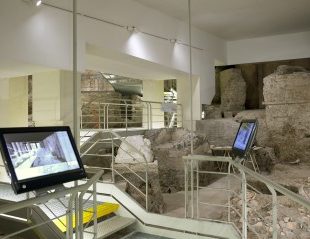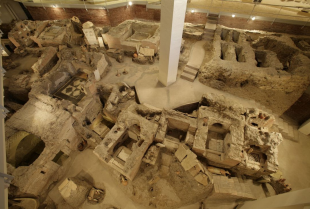
The Vatican reveals the Necropolis of the Via Triumphalis
Necropolis of the Via Triumphalis
The Roman-age archaeological excavations which extend below the whole of the Vatican hill will again be visible to the public – extended, refurbished and transformed into a museum replete with walkways and multi-media educational apparatus. In the new year it will be possible to walk through the burial chambers, accompanied by an expert multi-lingual guide, among small mausoleums, finely sculpted sarcophagi, statues, mouldings, mosaics, frescoes and bas-reliefs with epigraphs describing the lives of those who repose at the foot of the ancient hill.
The Vatican Museums are pleased to present the public opening of the extension of the archaeological area of the Necropolis along the Via Triumphalis, with a new visitors' itinerary enriched by a new display to be inaugurated on Wednesday 11 December 2013. Recent excavations carried out by the Department of Greek and Roman Art of the Vatican Museums from 2009 in the central area of the currently visible Necropolis have enabled the connection of the sectors of the Autoparco (excavated from 1956-1958) and Santa Rosa (excavated in 2003), separate until now.
At the same time, the material unearthed during the various excavation campaigns – both those carried out in the past and those of more recent times - has been recorded and catalogued. During the works carried out to furnish the display for public opening, the entire archaeological site remained open for study visits.
This challenging task was made possible thanks to the generous support offered by the Canada Chapter of the Patrons of the Arts in the Vatican Museums, which financed the recent excavations and the installation of new walkways and additional display cabinets, as well as the multi-media teaching apparatus. The visitor may consult touch-screen monitors in eleven locations, each of which illustrates the entire archaeological area and offers a detailed view of the specific surrounding area, with virtual reconstructions and informative notes on the tombs. The educational apparatus also includes a series of information panels and two films – an historic documentary and another offering three-dimensional reconstructions.
The new itinerary unfolds throughout the Necropolis, offering the visitor the opportunity to admire the burial ground in its entirety, and also to appreciate close-up the many decorative elements: marbles, mosaics, mouldings and frescoes recently restored to new splendour. Among the many new features of the excavation there is the discovery of an area destined for cremations (ustrino), rarely conserved in complexes of this type. Two new display cabinets have been furnished according to thematic criteria, regarding the burial goods used for funeral rites, personal objects belonging to the deceased, and the different preparations undertaken for incineration or for burial in earth. A third new display cabinet illustrates the excavations carried out from 2009-2011 according to the stratographic archaeological method, in order to demonstrate a synthetic "cross section" of the excavation site. Along the visitors' itinerary there are also archaeological finds from areas near the Necropolis but no longer visible (Annona Sector) or not currently open to the public (Galea Sector), to further complete and enhance the transformation of the site into a museum display.
To further confirm the objective of considering this archaeological area as a genuine research laboratory, it is opportune to mention here the research and scientific studies currently underway, such as imaging by georadar and anthropological analyses. With regard to the latter, research on cremations has been carried out by Professor Henri Duday of the University of Bordeaux, in collaboration with the Ecole Francaise in Rome, while burial in earth has been researched by the Anthropological Service of the Special Superintendency for the Archaeological Heritage of Rome, coordinated by Dr. Paola Catalano.

























